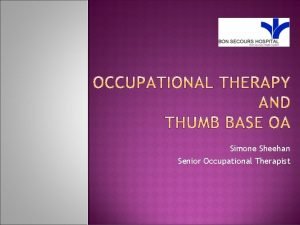Horses in Occupational Therapy Client and Therapist Perspectives

- Slides: 1

Horses in Occupational Therapy: Client and Therapist Perspectives Daniela Kovacevic, MSc. OT Candidate, Alanah Delaney, MSc. OT Candidate, Sandra Vander. Kaay, Ph. D, OT Reg. (Ont. ) School of Rehabilitation Science, Mc. Master University, Hamilton, Ontario Rationale • Horses have been involved in therapy for hundreds of years 1 • Recent research indicates benefits for varied populations 2, 3 • Limited understanding of implications for occupational therapy Emerging Themes Horses Dynamically Contribute to Therapy “The horses do the teaching. ” - Participant 3 Research Question What are therapists’ and clients’ perspectives on the experience of having a horse involved in occupational therapy? Natural Environment Adds Value “You can go and just be yourself, and not be judged. ” - Participant 6 Methods • Interpretive Phenomenology 4 • 9 participants interviewed: 6 occupational therapists (OTs) and 3 clients • Dedoose software used to code interview transcripts line-by-line • Emerging themes constructed by collapsing codes from 6 interview transcripts: 4 OTs and 2 clients • Thematic construction will continue to be informed by the 3 remaining participant interviews through an iterative process 4 Holistically Benefits All Components of the Person “Sensory, motor, cognitive… even emotional” - Participant 2 Poor Awareness and Understanding “It can be difficult to get the. . . recognition that you are doing something as a professional” - Participant 1 Implications for Practice Through the exploration of client and OT experiences, the impact of horses in occupational therapy will be better understood. Acknowledgements We would like to thank Angela Meyer, OT Reg. (Ont. ), for providing invaluable support and guidance as our community collaborator. References 1. Voynick S. Equestrian therapy: horseback riding offers physical and emotional advantages. East/West. 1988; 18(5): 14 -24. 2. Memishevikj H, Hodzhikj S. The effects of equine-assisted therapy in improving the psycho-social functioning of children with autism. Journal of Special Education and Rehabilitation. 2010 Sep 30; 11(3 -4): 57 -67. 3. Pohl P, Carlsson G, Käll LB, Nilsson M, Blomstrand C. A qualitative exploration of postacute stroke participants’ experiences of a multimodal intervention incorporating horseback riding. Plo. S one. 2018 Sep 20; 13(9) 4. Cohen MZ, Kahn DL, Steeves RH. Hermeneutic phenomenological research: a practical guide for nurse researchers. California: Sage Publications; 2000. Contact Information kovaced@mcmater. ca delaneam@mcmaster. ca

